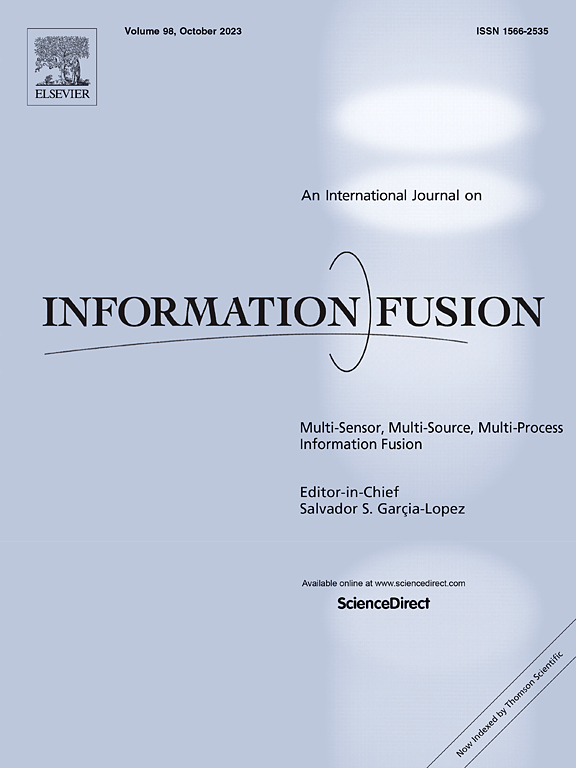基于llava的水下图像增强语义特征调制扩散模型
IF 15.5
1区 计算机科学
Q1 COMPUTER SCIENCE, ARTIFICIAL INTELLIGENCE
引用次数: 0
摘要
水下图像增强(UIE)是许多海洋应用的关键;然而,现有的方法往往无法解决严重的颜色失真、细节丢失和缺乏语义理解,特别是在空间变化的退化条件下。虽然生成式人工智能(GenAI),特别是扩散模型和多模态大型语言模型(mllm),为UIE提供了新的前景,但有效利用它们的能力进行细粒度、语义感知增强仍然是一个挑战。提出了一种基于llva的语义特征调制扩散模型(LSFM-Diff),该模型将多层语义引导协同集成到扩散模型的骨干网中。具体而言,首先采用优化的提示学习策略,从LLaVA中获得简洁的、与ie相关的文本描述。然后,这些语义在两个关键阶段指导增强过程:(1)窗口文本图像融合条件细化(WTIF-CR)模块将文本语义与局部图像特征在空间上对齐并融合,生成细粒度的外部条件,为扩散模型提供初始的空间感知语义蓝图。(2)语义引导可变形注意(SGDA)机制,利用基于梯度的图像-文本交互生成语义导航图,引导去噪网络内的注意力集中在关键的语义区域。在几个具有挑战性的基准数据集上进行的实验表明,LSFM-Diff优于当前最先进的方法。我们的工作强调了多层次语义引导融合策略深度集成在推进基于genai的ie开发中的有效性。本文章由计算机程序翻译,如有差异,请以英文原文为准。
LLaVA-based semantic feature modulation diffusion model for underwater image enhancement
Underwater Image Enhancement (UIE) is critical for numerous marine applications; however, existing methods often fall short in addressing severe color distortion, detail loss, and lack of semantic understanding, particularly under spatially varying degradation conditions. While Generative AI (GenAI), particularly diffusion models and multimodal large language models (MLLMs), offers new prospects for UIE, effectively leveraging their capabilities for fine-grained, semantic-aware enhancement remains a challenge. We proposed a LLaVA-based semantic feature modulation diffusion model (LSFM-Diff), which integrates multi-level semantic guidance collaboratively into the backbone network of the diffusion model. Specifically, an optimized prompt learning strategy is first employed to obtain concise, UIE-relevant textual descriptions from LLaVA. These semantics then guide the enhancement process in two key stages: (1) The windowed text-image fusion for condition refinement (WTIF-CR) module aligns and fuses textual semantics with local image features spatially, generating fine-grained external conditions that provide an initial spatially aware semantic blueprint for the diffusion model. (2) The semantic-guided deformable attention (SGDA) mechanism, leveraging a gradient-based image-text interaction to generate a semantic navigation map, guides the attention within the denoising network to focus on key semantic regions. Experiments conducted on several challenging benchmark datasets demonstrate that LSFM-Diff outperforms current state-of-the-art methods. Our work highlights the effectiveness of deep integration of multi-level semantic guidance fusion strategies in advancing GenAI-based UIE development.
求助全文
通过发布文献求助,成功后即可免费获取论文全文。
去求助
来源期刊

Information Fusion
工程技术-计算机:理论方法
CiteScore
33.20
自引率
4.30%
发文量
161
审稿时长
7.9 months
期刊介绍:
Information Fusion serves as a central platform for showcasing advancements in multi-sensor, multi-source, multi-process information fusion, fostering collaboration among diverse disciplines driving its progress. It is the leading outlet for sharing research and development in this field, focusing on architectures, algorithms, and applications. Papers dealing with fundamental theoretical analyses as well as those demonstrating their application to real-world problems will be welcome.
 求助内容:
求助内容: 应助结果提醒方式:
应助结果提醒方式:


